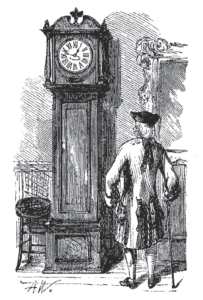The notion of the “nostalgic American” served liberals as an ideal whipping boy at a time when the intellectual foundations of liberalism were beginning to erode. As the dogma of progress became untenable, the “party of hope” salvaged something of its self-confidence—the appearance if not the substance of hope—by deploring the nostalgic mood that allegedly made so many Americans afraid to face the future. By the Sixties, the denunciation of nostalgia had become a liberal ritual, but such skirmishes provided only a foretaste of the campaign that followed. It was the nostalgia wave of the Seventies, as it has come to be called, that released an outpouring of analysis and denunciation. Whether or not Americans are more nostalgic than their ancestors, they’ll lend a willing ear to anyone with an explanation for why they suffer from this particular disease.
 These explanations can be reduced to three. The first line of interpretation, which insists that nostalgia expresses a legitimate revulsion against decadence, has never gained much currency. No one wants to listen to a defense of “radical nostalgia,” as Jim Hougan called it in his book Decadence. Hougan argued that radical nostalgia “would not merely mourn the loss of old values and ways, but would take action to have those values and ways reinstated.” The old values may have come back into style, as speakers at the Democratic Convention reminded us with their paeans to family, work ethic, and self-sacrifice. But it is one thing to evoke the old values in a spirit of sentimental regret, and another to turn back the clock. As Hougan wrote, nostalgia rarely forms the basis of serious resistance to change, even when resistance is justified; in our time, it is more likely to “decay into a pervasive wistfulness that falsifies the past and serves, not as a lever in the present, but as an escape from it.”
These explanations can be reduced to three. The first line of interpretation, which insists that nostalgia expresses a legitimate revulsion against decadence, has never gained much currency. No one wants to listen to a defense of “radical nostalgia,” as Jim Hougan called it in his book Decadence. Hougan argued that radical nostalgia “would not merely mourn the loss of old values and ways, but would take action to have those values and ways reinstated.” The old values may have come back into style, as speakers at the Democratic Convention reminded us with their paeans to family, work ethic, and self-sacrifice. But it is one thing to evoke the old values in a spirit of sentimental regret, and another to turn back the clock. As Hougan wrote, nostalgia rarely forms the basis of serious resistance to change, even when resistance is justified; in our time, it is more likely to “decay into a pervasive wistfulness that falsifies the past and serves, not as a lever in the present, but as an escape from it.”
A more plausible explanation is advanced by Alvin Toffler in Future Shock. The transition from an industrial society to a postindustrial society leaves people confused—they cannot face the future and seek refuge in the past. Reactionary “reversionists’’ like Barry Goldwater and George Wallace “yearn for the simple, ordered society of the small town,” Toffler wrote, while the left develops its own iteration based on “bucolic romanticism” and an “exaggerated contempt for science and technology.” In Toffler’s view, both the left and the right harbor a “secret passion for the past.” By exaggerating the naïve simplicity of earlier times, nostalgia implicitly celebrates the maturity and worldly wisdom with which we look back on them.
A third explanation comes from the sociologist Fred Davis. The “nostalgia wave,” he argues, was a response to the “massive identity dislocations” of the Sixties. “Rarely in history has the common man had his fundamental . . . convictions . . . so challenged, disrupted, and shaken.” Nostalgic “reactions” occur “in the wake of periods of severe cultural discontinuity”; but instead of impeding change, nostalgia facilitates it. It provides collective therapy and enables a sense of personal and generational identity—the illusion of continuity in a society subject to rapid change.
The trouble with this interpretation, of course, is that a sense of continuity is exactly what nostalgia discourages. It provides neither a necessary sense of persistence in a time of rapid change nor an unadulterated escapism. One of the delusions peculiar to our age is that we can manipulate the past to suit our immediate purposes—that we can adopt an eclectic approach to history, appropriating whatever we need in order to piece together a “usable past.” Revivals endow the past with the charm of distance and inconsequence. Nostalgia evokes the past only to bury it alive.
From “The Politics of Nostalgia,” which appeared in the November 1984 issue of Harper’s Magazine.






















































































